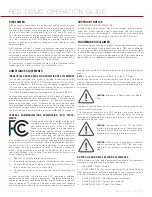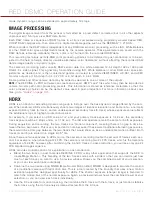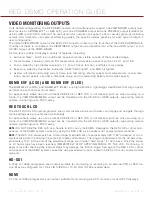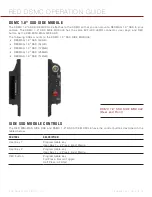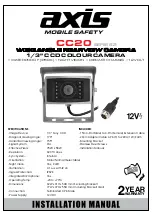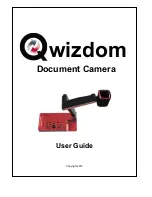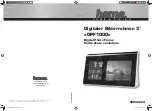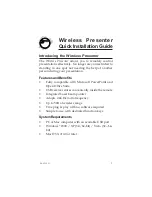
COPYRIGHT © 2013 RED.COM, INC
RED DSMC OPERATION GUIDE
955-0020_V5.1, REV-D
|
8
mode, dynamic range can be extended to approximately 18 stops.
IMAGE PROCESSING
The digital image received from the sensor is formatted as a pixel defect corrected (but in all other aspects
unprocessed) 16-bit per pixel RAW data frame.
Each RAW frame or sequence of RAW frames in a clip is compressed using proprietary wavelet based RED-
CODE
®
RAW compression, then stored to a digital media magazine such as the REDMAG
™
1.8” SSD.
When recorded, the RAW data is independent of any RGB domain color processing such as ISO, White Balance
or other RGB color space adjustments made by the camera operator. These parameters are saved with the
RAW data as reference metadata; that is, color is not burned into the recorded RAW data.
This recording technique permits RGB color processing choices to be deferred to post-production or to be ad-
justed in the field to help a director visualize alternative color treatments, without affecting the recorded RAW
data’s image quality or dynamic range.
The camera’s monitoring path converts RAW sensor data to a white balanced 12-bit depth 1920 x 1080 pixel
RGB 4:4:4 video signal. This signal may be modified using ISO, White Balance or other RGB color space ad-
justments as desired, and is then scaled and gamma-corrected to provide VIEWFINDER, HD-SDI, and HDMI
monitor outputs at 10-bit depth in 4:2:2 YCC or 8-bit depth in 4:4:4 RGB.
Frame guides and other camera data may be added as desired to one or more of the outputs.
NOTE:
The REDCINE-X
®
PRO software can create and export .RMD “Look” files which may then be imported as
camera monitor path color processing presets. This information is stored as reference metadata, so that this
color processing choice can be the default value used in post-production. For more information about Look
files, go to
.
HDRX
HDRx is an option for extending dynamic range up to 6 stops over the base dynamic range offered by the cam-
era. When enabled, HDRx simultaneously shoots two images of identical resolution and frame rate—a normally
exposed primary track (A-track), and an underexposed secondary track (X-track) whose exposure value reflects
the additional stops of highlight protection desired.
For example, if you select an HDR value of +2 and your primary track exposure is 1/48 sec, the secondary
track exposure will be 2 stops under, or 1/192 sec. The ISO and aperture remain the same for both exposures.
During acquisition and recording, the two tracks are “motion-conjoined”, meaning there is no gap in time be-
tween the two exposures. This is very important to note because if these were traditional alternating exposures,
there would be a time gap between the two tracks that would show up as an undesirable motion artifact. Both
tracks (A and X) are stored in a single .R3D
®
file.
Since there are two exposures in HDRx mode, the camera is recording double the amount of frames each sec-
ond. For example, when shooting at 24 FPS, the camera is recording two 24 FPS tracks, which is the data rate
equivalent of 48 FPS; however, after combining the A and X tracks in post-production, you will see only one 24
FPS blended image sequence.
HDRx provides multiple options for exploitation in post-production.
Blend the two tracks in post tools like REDCINE-X PRO or any other application that supports the SDK to
create Magic Motion
™
. This blending of the two tracks comes with a slider so that you can decide just how
much of each track you want to use. A preview window shows you the combined result of your selection,
or you can view each track individually.
Combine the two tracks using MNMB (More Normal Motion Blur). MNMB is designed to emulate the motion
of a traditional camera with full motion blur. This is a tool created by The Foundry that uses a new motion
estimation algorithm designed specifically for HDRx. The shorter exposure (sharper image) is blended to
match the motion blur of the normal exposure. Again, a preview window shows the combined result of your
selection, or you can view each track individually.
Use the X-track data for motion tracking, then combine the X-track with the A-track, or just motion stabilize
the A-track using the motion analysis data extracted from the X-track.
Содержание Dragon
Страница 1: ...EPIC SCARLET V5 1 DRAGON MYSTERIUM X RED COM RED DSMC O PERAT ION GU IDE ...
Страница 161: ...RED DSMC OPERATION GUIDE COPYRIGHT 2013 RED COM INC 955 0020_V5 1 REV D 161 SIDE VIEW ...
Страница 162: ...COPYRIGHT 2013 RED COM INC RED DSMC OPERATION GUIDE 955 0020_V5 1 REV D 162 TOP VIEW ...
Страница 163: ...RED DSMC OPERATION GUIDE COPYRIGHT 2013 RED COM INC 955 0020_V5 1 REV D 163 BOTTOM VIEW ...
Страница 164: ...COPYRIGHT 2013 RED COM INC RED DSMC OPERATION GUIDE 955 0020_V5 1 REV D 164 BACK VIEW ...




